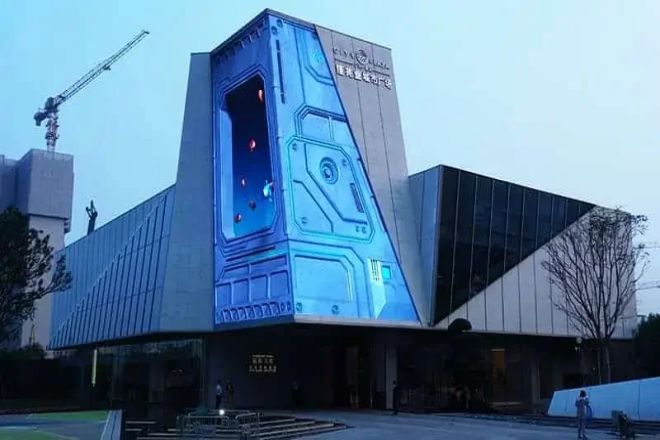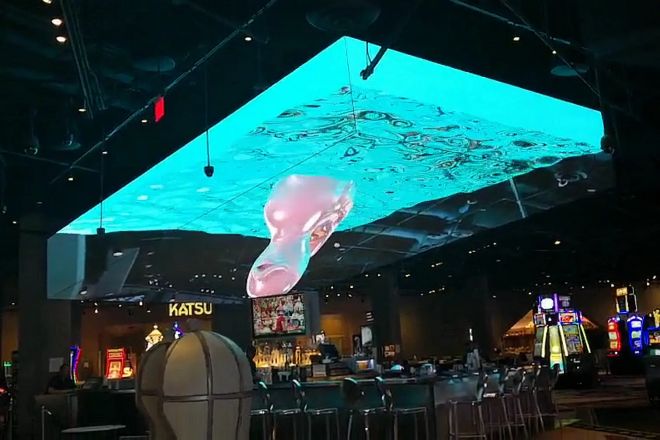소개

The birth of a 3D LED display screen marks a historic leap in display technology from a two-dimensional plane to a three-dimensional one. Through the dense arrangement and precise control of LED lamp beads, it achieves the precise presentation of images in three-dimensional space, bringing a more realistic and vivid visual experience to the audience.
At the same time, with the continuous advancement of new display technology, flexible display technology, miniaturization, and integration technology, 3D LED displays have also made significant breakthroughs in display effects, design space, and application scenarios.
However, the development of 3D LED displays has not been smooth sailing. High costs, technical bottlenecks, and market acceptance issues have always plagued this emerging field. So, how should 3D LED displays develop in the future? Let’s make some predictions together.
1. Technological innovation drives the development of 3D LED displays.
- The emergence and upgrading of new display technologies
With the rapid development of technology, the visual experience of 3D LED displays has also been greatly improved. This is all thanks to new display technologies that are constantly emerging.
First of all, high-resolution technology makes the images on the 3D LED display more detailed and clear. You can see even smaller details, and it’s like you’re actually in a three-dimensional world.
Secondly, high refresh rate technology makes the dynamic images on the screen very smooth. Image delays or smearing that may have occurred before are now almost invisible, making the picture more natural and realistic.
Furthermore, wide color gamut technology makes the colors of the display more vivid and rich. You can see richer colors, making the picture more vivid and realistic.
The upgrade and improvement of these new display technologies have made the visual effects of 3D LED displays better and better and also made them more widely used in various fields. Whether in movie theaters, game arcades, shopping malls, or exhibitions, 3D LED displays can bring us a more shocking visual experience.
- Maturity and application of flexible display technology
The maturity of flexible display technology has brought revolutionary changes to 3D LED displays. Compared with traditional rigid displays, flexible displays have better bending and folding properties and can adapt to various complex curved surfaces and shapes. This provides a broader design space and application scenarios for 3D LED displays, such as wearable devices, automotive interiors, building exteriors, and other fields.
At the same time, flexible display technology can also achieve thinner and more portable display designs, meeting consumers’ needs for portability and aesthetics.
- Breakthroughs in miniaturization and integration technology
The advancement of miniaturization and integration technology is the key to promoting the development of 3D LED displays to smaller sizes and higher integration levels. By using advanced packaging technology and miniaturization design, a large number of LED lamp beads can be integrated on a tiny chip to achieve high-density pixel arrangement.
This not only reduces the size and weight of the display but also improves the display effect and reliability. At the same time, integrated technology can also integrate display screens with control circuits, drive circuits, etc., simplifying the production process and reducing production costs. Breakthroughs in these technologies provide strong support for the widespread application of 3D LED displays.
2. Market demand drives 3D LED display innovation

- Consumers’ pursuit and upgrade of visual experience
As people’s quality of life improves, consumers’ requirements for visual experience are also constantly increasing. Traditional flat displays can no longer satisfy their pursuit of realism and three-dimensionality, while 3D LED displays can bring them a more vivid and realistic visual experience.
Therefore, in entertainment, advertising, and other fields, the application of 3D LED displays has been widely expanded. Entertainment venues such as cinemas and game arcades use 3D LED displays to bring an immersive viewing experience to audiences, while advertisers use the three-dimensional effect of 3D LED displays to attract more consumers’ attention.
- Commercial display’s desire for effect and innovation
The commercial field has increasingly higher requirements for display effects. Traditional display methods can no longer meet the needs of merchants to attract customers and enhance brand image. The 3D LED display screen, with its unique three-dimensional effect, can provide merchants with a more vivid and intuitive display method.
In exhibitions, conferences, and other occasions, 3D LED displays are widely used in product display, corporate promotion, and other aspects to help businesses better convey information and attract audiences.
- New opportunities for smart cities and smart transportation
With the rapid development of smart cities, smart transportation, and other fields, 3D LED displays have also ushered in new market opportunities.
In the construction of smart cities, 3D LED displays can be used for public information release, traffic guidance, etc., to improve the intelligent level of urban management. In the field of intelligent transportation, 3D LED displays can be used for traffic signal instructions, real-time display of road conditions, etc., to improve road traffic efficiency and safety.
The development of these emerging fields provides a broad market space for 3D LED displays and promotes continuous innovation and improvement of its technology.
3. Industry cooperation and standardization promote the development of 3D LED displays
- Integrated development of cooperation and competition among enterprises
In the field of 3D LED display screens, cooperation and competition between enterprises complement each other and jointly promote technological progress and market prosperity.
On the one hand, major companies jointly develop new technologies and products through technical cooperation, achieve resource sharing and complement each other’s advantages, and accelerate the upgrading of 3D LED display technology. This kind of cooperation not only improves R&D efficiency but also reduces the company’s R&D costs, providing strong support for the rapid expansion of the market.
On the other hand, fierce market competition also prompts companies to continuously improve their technical level to meet market demand. In order to stand out from the competition, companies have increased investment in R&D and launched more innovative and competitive products.
This competitive atmosphere not only promotes the continuous advancement of 3D LED display technology but also brings consumers more diverse and higher-quality product choices.
- The driving force of the International Organization for Standardization
The International Organization for Standardization plays a pivotal role in the development of 3D LED displays. These organizations are committed to formulating and promoting unified technical standards to ensure that 3D LED displays produced by different manufacturers are compatible with each other and reduce production costs and market access barriers.
Through the standardization process, technical barriers can be eliminated, close cooperation between upstream and downstream enterprises in the industrial chain can be promoted, and the healthy development of the entire industry can be promoted.
At the same time, the International Organization for Standardization also pays attention to product safety, reliability, and environmental performance requirements to ensure that 3D LED displays meet market demand while also complying with relevant regulations and standards.
The formulation and implementation of these standards provide a strong guarantee for the widespread application of 3D LED displays and also enhance the image and competitiveness of the entire industry.
4. Forecast of future development trends

- High-definition, intelligent, and personalized development
With the continuous advancement of technology and increasingly diversified consumer demands, 3D LED displays will further achieve high-definition, intelligence, and personalized development. High-definition means that the resolution of the display will continue to increase, presenting more delicate and realistic image effects to meet the audience’s demand for a high-quality visual experience.
Intelligence means that the display screen will have stronger interactivity and intelligent functions and can be intelligently adjusted and displayed according to different scenarios and needs, providing more convenient and efficient services.
Personalized development means that the display screen will pay more attention to user experience and personalized needs, providing customized and differentiated products and services to meet the unique needs of different fields and consumers.
- Integrate with new technologies such as AR and VR
With the rapid development of technologies such as AR (augmented reality) and VR (virtual reality), 3D LED displays will be more closely integrated with these new technologies to create a more immersive visual experience.
Through AR technology, the display screen can combine virtual content with real scenes to bring users a more vivid and real experience. VR technology allows users to fully immerse themselves in the virtual world and deeply interact with the content presented on the display.
This combination will bring revolutionary changes in entertainment, education, medicine, and other fields, as well as unprecedented new experiences for users.
- Realize efficient remote control and data transmission with the help of 5G and IoT technology
With the popularization and application of 5G and IoT technology, 3D LED displays will achieve more efficient remote control and data transmission. The high-speed and low-latency characteristics of 5G technology will make remote control and real-time interaction smoother and more convenient, providing strong support for remote management and maintenance of displays.
At the same time, IoT technology can connect the display screen with various smart devices and systems to realize real-time collection, analysis, and sharing of data and promote the development of smart displays.
This will allow display screens to play a more important role in smart cities, smart transportation, smart homes, and other fields, providing people with a more intelligent and convenient life experience.
결론
After an in-depth discussion of the future development trends of 3D LED displays, it is not difficult to find that this field is at a crossroads full of opportunities and challenges.
The continuous innovation of technology and the continuous expansion of the market provide broad space for the development of 3D LED displays.
Finally, if you want to know more about 3D LED displays, 우리에게 연락해주세요.
